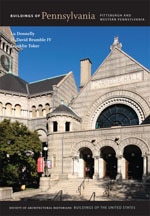
Bavarian Carmelite priest Cyril Knoll came to New Baltimore and assumed responsibility for the local parish and school. By 1890, a rectory and a school for Carmelite novices were built. Anticipating continued growth due to the proximity of the proposed South Pennsylvania Railroad, the Carmelite order replaced the smaller stone church with the present brick church, using plans supplied from Germany by members of the order. The impressive, brick Romanesque Revival building, visible from the Pennsylvania Turnpike, has smooth English bond masonry, round-arched door and window openings, and a tall, square tower in the center of the facade. The church's interior is paneled in oak, and the furniture, including the altar, was built by Henry Engbert, a carpenter whose work is in Pittsburgh and many other central Pennsylvania churches. The South Pennsylvania Railroad was never completed, and New Baltimore stagnated. The Carmelite novices moved to Niagara in 1915, but construction of the Pennsylvania Turnpike brought the Carmelites back to the area in the 1940s. They negotiated with the commonwealth to allow an area for people to pull off the turnpike and walk the fifty yards to the church, the only

